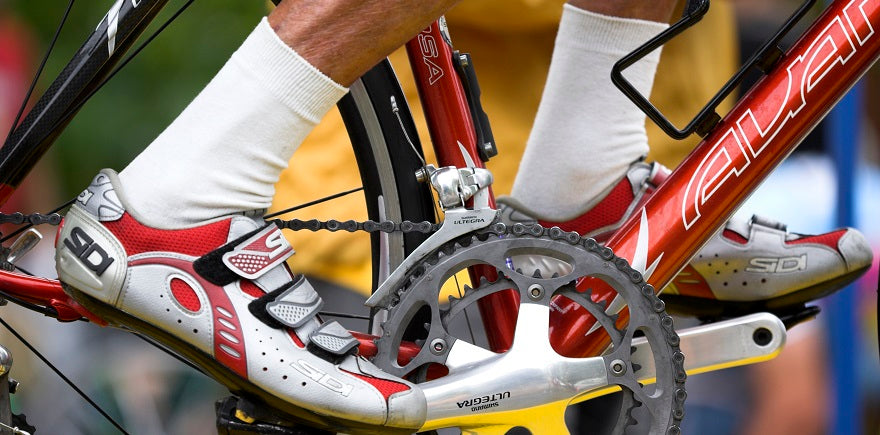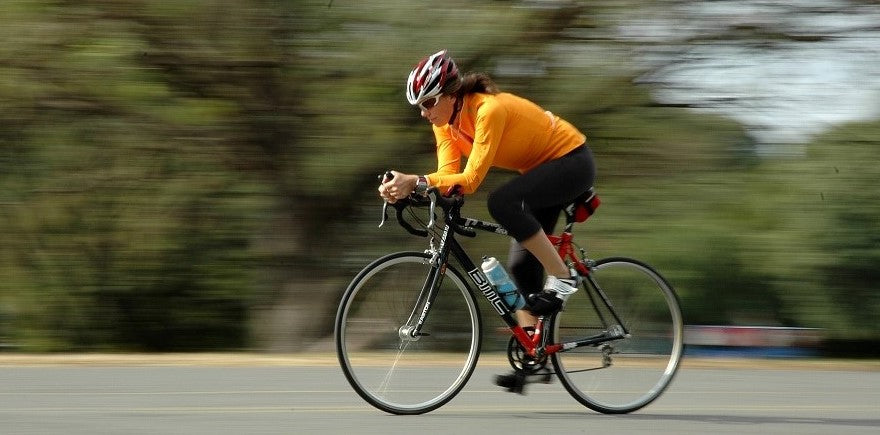
How Cycling Insoles Can Help You Go Faster
Just about every cyclist has one goal - go further, faster. There are lots of ways to get there, but after you've trained hard and dropped weight from your bike, you have to focus on the one thing that really matters - biomechanics.
The Basics ---
- Cycling further, faster comes from a combination of factors - the right training, nutrition, bike setup, and biomechanics.
- Cycling concentrates maximum pressure over a small area at the ball of your foot which can lead to common issues like 'hot spots' and the tingling that happens when your feet fall asleep.
- Adding arch support in your cycling shoes can help with common biking foot issues as well as problems associated with poor musculoskeletal alignment by evenly distributing the force of your pedal stroke and aligning the bones in your feet.
- We recommend Tread Labs Dash Insoles for cyclists who want improved biomechanics and superior energy return from an ultra-firm carbon fiber arch support and ventilated top cover.
What You Need To Know ---
Bike biomechanics are a lot of different factors that come together to bring you and your bike into perfect harmony. They include:
- Your joints and muscles
- Load Factors
- Angles
- Equipment
- Point-of-contact positioning
- Pedal force measurements
Our focus is on the point-of-contact positioning piece of bike biomechanics, which is where the pedal meets your foot and cycling shoe. This is where small changes can make a big difference.
Cycling shoes rely on a snug fit and a stiff sole to transmit power from your foot to your bike. Cleated shoes minimize wasted energy between your shoe and the pedal. But, is the connection between your foot and your shoe as efficient as it could be?
Do the Math
Cycling puts a tremendous amount of force on a small area of your foot (mainly the ball of the foot), especially on longer rides. All this force, over and over again, can lead to common conditions like:
- Low back pain
- Anterior or lateral knee pain
- Arch pain
- Forefoot pain
- Foot numbness
Stiff soles help to spread the force, but without a supportive insole, much of the stress will still be on the ball of your foot. If you're spending a couple hours pedaling, that can add up to a lot of stress.
Ever wonder how many times you actually spin your pedals on a longer ride?
Do the math: a 2-hour ride at a cadence (pedal revolutions/minute) of 85
-
2 (hours) x 60 (minutes) x 85 (cadence) = 10,200 pedal revolutions.
Yikes! With such a highly repetitive activity, no wonder your feet get sore, especially if you're just working with that flimsy, flat, foam insole that came in your cycling shoe. Your feet need to be properly supported to withstand the pressure you put on them during your ride. Adding firm arch support insoles for cycling can make all the difference.

How Do Cycling Insoles Help?
As Cycling Performance Engineer Martin Choo and Podiatrist Nathan White put it, cycling insoles "support the foot, increase stability and improve knee alignment by providing a stable platform through the pedal stroke."
They continue, "with each pedal stroke, the support of an insole alters the dynamics of the foot pronation, which subsequently reduces the amount of "wobble" in the knees, thereby improving alignment and efficiency."
Improved alignment and efficiency aren't the only benefit you get from adding insoles for cycling to your cleats. Other ways cycling insoles can help include:
- Hotspot elimination - By distributing pedal pressure over a greater area of the foot, you'll reduce the pressure in specific areas that lead to hotspots.
- Less strap pressure - Proper arch support in your cycling shoes locks into the contour of the arches of your feet. That means less strap pressure is needed to keep your feet snug in your shoes.
- Slippage minimization - Arch support makes your cycling shoes fit better, which means less friction. Less friction keeps your feet cooler and more comfortable, especially on long rides.
- Reduction in forefoot pressure - Forefoot pressure can cause your feel to feel tingly or fall asleep during your ride. Reducing that pressure can help you avoid the discomfort of numb or tingling feet.
In addition to all these benefits, what may be even more important is what cycling footbeds can do help you avoid injury. According to Physiopedia, "the foot has many small joints but primarily this is where the force that is generated from the lower limb complex is transferred to the pedal. Irregular amounts of force or compression running through the foot can result in neural pain and tissue damage from compression."
Now that it's clear how much of a positive difference cycling insoles can make, the next step is figuring out which ones are right for you.
Do I Need Custom Orthotics For Cycling?
There are two types of orthotics: custom-made orthopedic insoles and over-the-counter insoles. Custom insoles are prescribed by a podiatrist or other medical professional and can be very expensive. Over-the-counter insoles are available without a prescription.
The truth is, for most people, custom orthotics are not necessary. Dr. Richard Braver, a Sports Podiatrist and Doctor of Podiatric Medicine says, custom-made orthotics should be a last option. Over-the-counter insoles should be the go-to unless you have diabetes or serious biomechanical issues and recurring injuries that aren't addressed with over-the-counter versions.
What's really important when you're selecting insoles for cycling is understanding all the available options so you know which is best for you.
What Are The Best Cycling Insoles?
Insoles are like bikes. They need to fit well and provide support to your arch that is firm enough to efficiently turn your power into speed. And they need to be purpose built.
Think about it this way. Taking a full-suspension mountain bike out on a long road ride is rough because it's not built for road speed. As Pedorthist Graham Archer points out, "orthotics that are designed for cycling are quite different than those designed for running or walking. Since the primary point of contact is the forefoot, the hindfoot of the orthotics will be very low profile."
He continues, "materials used in cycling orthotics are generally very light and on the stiffer side." With that in mind, when you're thinking about buying insoles for your bike shoes, look for ones that:
- Fit your feet perfectly. You wouldn't consider getting a one-size-fits-all bike. So why would you get a one-size-fits-all insole? Find an insole that comes in different arch heights so you can choose the ones that match the contours of your feet.
- Give Firm Support. Like a good bike frame, insoles need to be firm enough for power transfer, and compliant enough for comfort. Grinding up a hill or sprinting to catch your friends generates significant forces on your feet. You won't get the support you need from foam or soft plastic insoles that are easily deflected. Firm plastic insoles work well, but if you're looking for the ultimate in firmness and performance, look for insoles made with carbon fiber.
- Are Thin And Light. You're a maniac about shedding weight from your bike, so don't go and add it to your shoes. Carbon fiber insoles are lightweight, while still being durable enough to hold up to the miles you'll put on them.
- Will Last Season After Season. Cycling is an expensive enough hobby as it is. You don't need the cost of replacing your insoles year after year adding up. Tread Labs insoles all use a two-part system that lets you replace your top covers whenever you need without breaking the bank.
You've spent a few bucks on your ride and whether you're racking up the miles or hitting shorter distances, you know how important comfortable feet are. Make your ride even better by adding a pair of insoles to your cycling shoes and see how much further you can go.
Questions? Drop us a line at hello@treadlabs.com. We're here to help.
